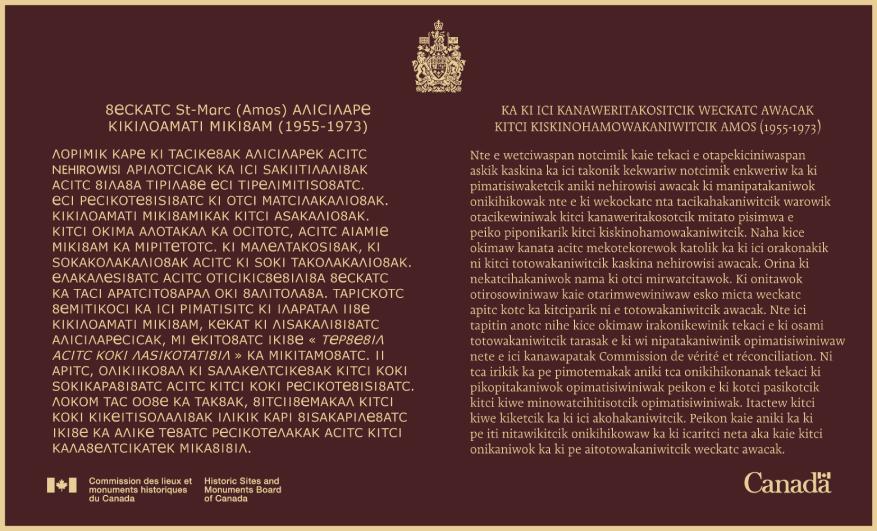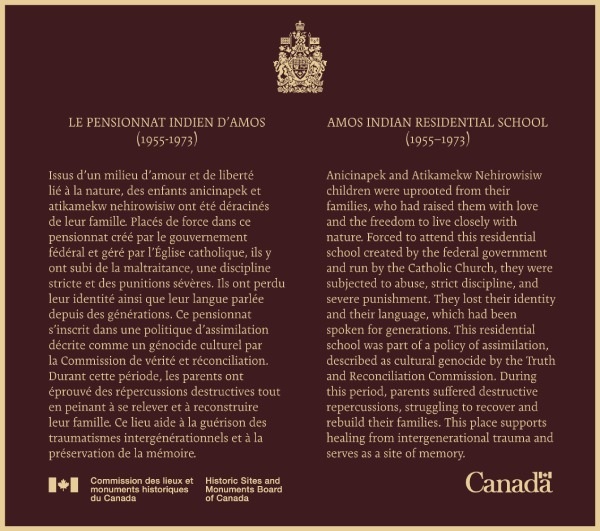Amos Indian Residential School (1955–1973)
Parks Canada is working with Survivors, Indigenous communities and organizations to install a Historic Sites and Monument Board of Canada bronze plaque to mark the designation of the Residential School System National Historic Event at former residential school sites.
Interested communities should contact Parks Canada : clmhc-hsmbc@pc.gc.ca.
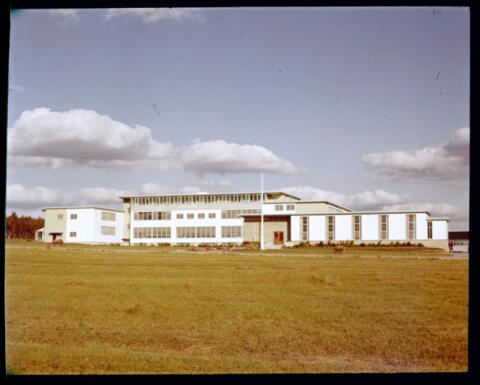
© Deschatelets-NDC Archives in Richelieu, Quebec
Amos Indian Residential School was commemorated with a bronze plaque as part of the Residential School System National Historic Event in 2024.
Commemorative plaque: Amos Indian Residential School (1955–1973), Saint-Marc-de-Figuery, QuebecFootnote 1
Amos Indian Residential School (1955–1973)
Anicinapek and Atikamekw Nehirowisiw children were uprooted from their families, who had raised them with love and the freedom to live closely with nature. Forced to attend this residential school created by the federal government and run by the Catholic Church, they were subjected to abuse, strict discipline, and severe punishment. They lost their identity and their language, which had been spoken for generations. This residential school was part of a policy of assimilation, described as cultural genocide by the Truth and Reconciliation Commission. During this period, parents suffered destructive repercussions, struggling to recover and rebuild their families. This place supports healing from intergenerational trauma and serves as a site of memory.
8ECKATC St-Marc (Amos) ANICINAPE KIKINOAMATI MIKI8AM (1955-1973)
NOPIMIK KAPE KI TACIKE8AK ANICINAPEK ACITC NEHIROWISI APINOTCICAK KA ICI SAKIITINANI8AK ACITC 8INA8A TIPINA8E ECI TIPENIMITISO8ATC. ECI PECIKOTE8ISI8ATC KI OTCI MATCINAKANIO8AK. KIKINOAMATI MIKI8AMIKAK KITCI ASAKANIO8AK. KITCI OKIMA ANOTAKAN KA OCITOTC, ACITC AIAMIE MIKI8AM KA MIPITETOTC. KI MANENTAKOSI8AK, KI SOKAKONAKANIO8AK ACITC KI SOKI TAKONAKANIO8AK. ENAKANESI8ATC ACITC OTICIKIC8E8INI8A 8ECKATC KA TACI APATCITO8APAN OKI 8ANITONA8A. TAPICKOTC 8EMITIKOCI KA ICI PIMATISITC KI INAPATAN II8E KIKINOAMATI MIKI8AM, KEKAT KI NISAKANI8I8ATC ANICINAPECICAK, MI EKITO8ATC IKI8E « TEP8E8IN ACITC KOKI NASIKOTATI8IN » KA MIKITAMO8ATC. II APITC, ONIKIIKO8AN KI SANAKENTCIKE8AK KITCI KOKI SOKIKAPA8I8ATC ACITC KITCI KOKI PECIKOTE8ISI8ATC. NOKOM TAC OO8E KA TAK8AK, 8ITCII8EMAKAN KITCI KOKI KIKEITISONANI8AK INIKIK KAPI 8ISAKAPINE8ATC IKI8E KA ANIKE TE8ATC PECIKOTENAKAK ACITC KITCI KANA8ENTCIKATEK MIKA8I8IN.
KA KI ICI KANAWERITAKOSITCIK WECKATC AWACAK KITCI KISKINOHAMOWAKANIWITCIK AMOS (1955-1973)
Nte e wetciwaspan notcimik kaie tekaci e otapekiciniwaspan askik kaskina ka ici takonik kekwariw notcimik enkweriw ka ki pimatisiwaketcik aniki nehirowisi awacak ki manipatakaniwok onikihikowak nte e ki wekockatc nta tacikahakaniwitcik warowik otacikewiniwak kitci kanaweritakosotcik mitato pisimwa e peiko piponikarik kitci kiskinohamowakaniwitcik. Naha kice okimaw kanata acitc mekotekorewok katolik ka ki ici orakonakik ni kitci totowakaniwitcik kaskina nehirowisi awacak. Orina ki nekatcihakaniwok nama ki otci mirwatcitawok. Ki onitawok otirosowiniwaw kaie otarimwewiniwaw esko micta weckatc apitc kotc ka kitciparik ni e totowakaniwitcik awacak. Nte ici tapitin anotc nihe kice okimaw irakonikewinik tekaci e ki osami totowakaniwitcik tarasak e ki wi nipatakaniwinik opimatisiwiniwaw nete e ici kanawapatak Commission de vérité et réconciliation. Ni tca irikik ka pe pimotemakak aniki tca onikihikonanak tekaci ki pikopitakaniwok opimatisiwiniwak peikon e ki kotci pasikotcik kitci kiwe minowatcihitisotcik opimatisiwiniwak. Itactew kitci kiwe kiketcik ka ki ici akohakaniwitcik. Peikon kaie aniki ka ki pe iti nitawikitcik onikihikowaw ka ki icaritci neta aka kaie kitci onikaniwok ka ki pe aitotowakaniwitcik weckatc awacak.
Amos Indian Residential School (1955–1973)
Between 1955 and 1973, Anicinapek children from southwest Quebec and Atikamekw Nehirowisiw children from the Mauricie region, aged 6 to 17, were uprooted from their families and placed in the Amos Indian Residential School. The Canadian government built the school in the municipality of Saint-Marc-de-Figuery, Quebec, on the traditional territory of the Anicinape Nation and appointed the Oblates of Mary Immaculate to administer the school with the assistance of the Soeurs de Saint François d’Assise. Children at the school were mistreated and subjected to abuse, strict discipline, and severe punishment. They were not allowed to speak their native language at any time, even when their parents visited them. By the time they left the residential school, many children had forgotten how to speak their native language, which had been spoken for generations. During this period, parents suffered destructive repercussions, struggling to recover and rebuild their families.
The Amos Residential School was part of the residential school system for Indigenous children officially put in place by the federal government in the 19th and 20th centuries. This system stretched across Canada in the 1880s and was in existence until the late 1990s. According to estimates, at least 150,000 First Nations, Inuit and Métis children attended the schools. The system was imposed on Indigenous Peoples as part of a broad set of deliberate assimilation efforts designed to destroy their rich cultures and identities and suppress their histories. In 2015, the Truth and Reconciliation Commission described the policy as cultural genocide.
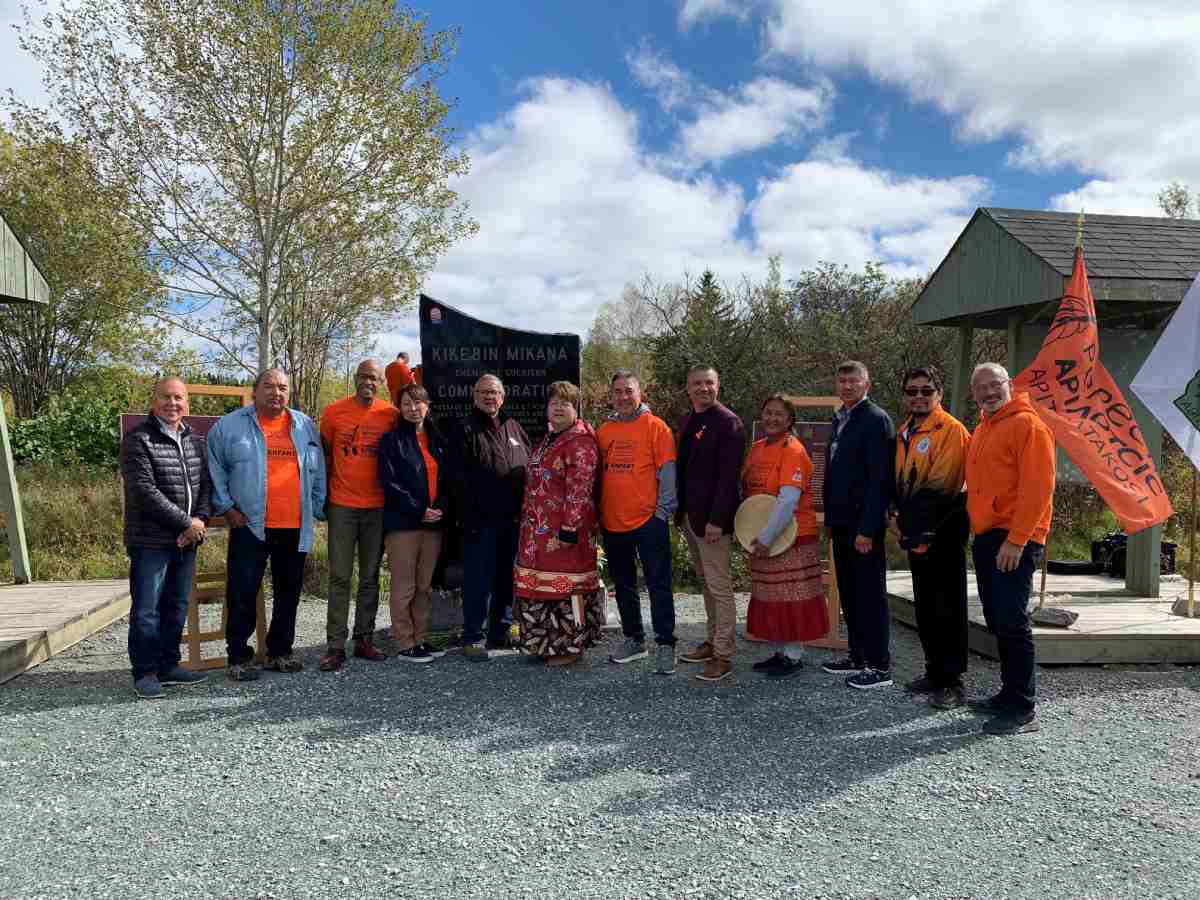
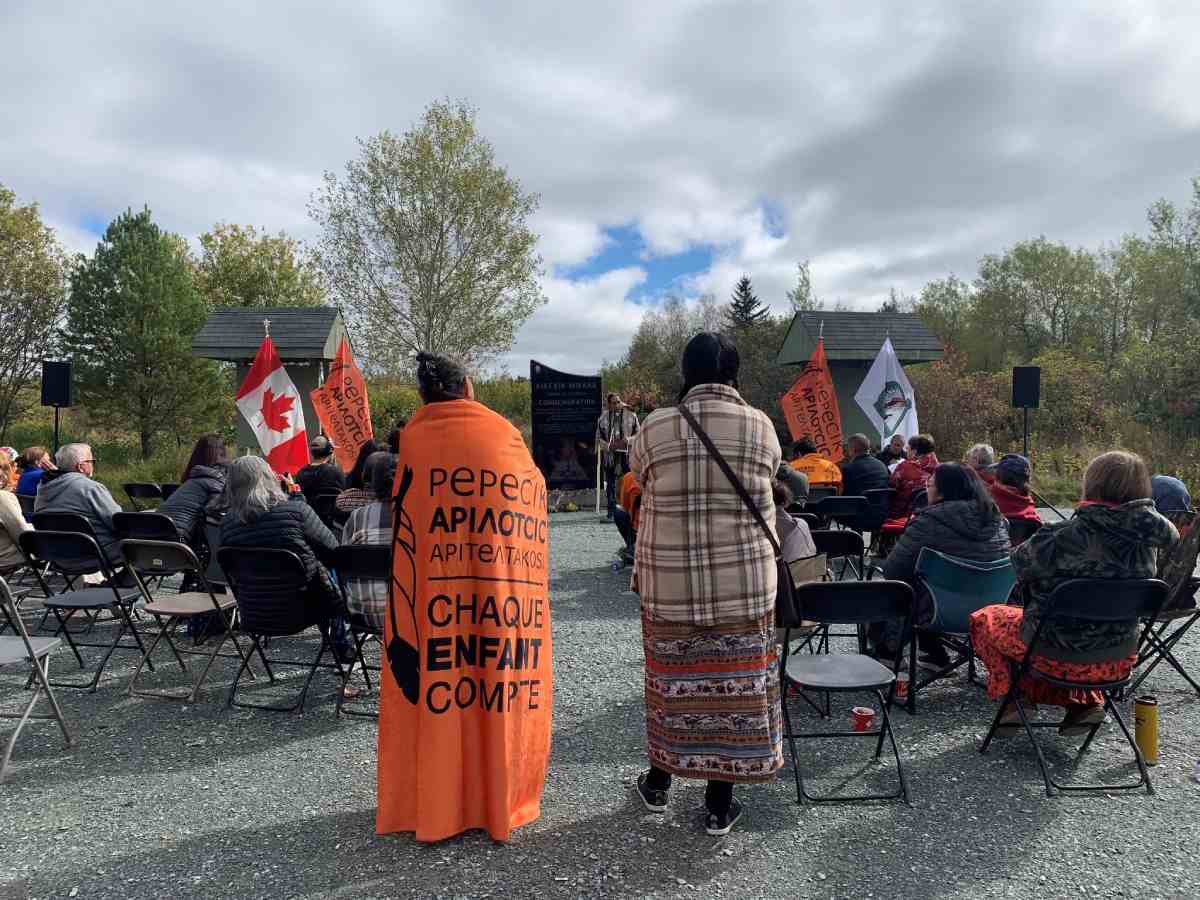
Community gathering during which two Historic Sites and Monuments Board of Canada were unveiled to commemorate the Amos Residential School’s history as part of the Residential School System National Historic Event, Saint-Marc-de-Figuery, Quebec.
Left to right: André Rioux, mayor of Saint-Marc-de-Figuery; Johnny Wylde, Amos Residential School Alumnus and Residential School Alumni Coordinator; Aly Ndiaye, Quebec Representative at the Historic Sites and Monuments Board of Canada; Nadine Spence, vice-president Indigenous Affairs and Cultural Heritage, Parks Canada; Tom Mapachee, Master of Ceremony and former student at Residential School; Chief Chantal Kistabish, Abitibiwinni Council of Pikogan; Malik Kistabish, director of the Pikogan Community Health Center; Grand Chief Constant Awashish, Council of the Atikamekw Nation; Gloria Polson, singer; Chef Lucien Wabanonik, Lac Simon; Chief Regis Penosway, Anicinapek Council of Kitcisakik; Sébatien D’Astous, mayor of Amos
© Parks Canada / Marie-Félyxe Myette
When the Amos Residential School opened, the government set up a farm school, but it was short-lived and the livestock was sold off in 1958. Constructed based on modern architectural principles, the main building was designed to receive 200 students. Over the years, the number of children at the school increased and eventually exceeded the initial capacity. All the buildings associated with the Amos Residential School have been demolished. In 2013, former students of the residential school and the Abitibiwinni First Nation Council erected a commemorative monument and interpretive panels that present the school’s history in order to make the site a place for remembrance and healing.
At the request of Elders of the Abitibiwinni First Nation of Pikogan who were sent to the Amos Residential School, and with the support of residential school Survivors of the Anicinapek and Atikamekw Nehirowisiw First Nations, the Amos Residential School’s history is commemorated as part of the Residential School System National Historic Event, designated in 2019. Parks Canada and Survivors worked jointly to draft the plaque text commemorating the history of the Amos residential school.
“We are still here”
This press backgrounder was prepared at the time of the plaque unveiling in 2024.
The National Program of Historical Commemoration relies on the participation of Canadians in the identification of places, events and persons of national historic significance. Any member of the public can nominate a topic for consideration by the Historic Sites and Monuments Board of Canada.
- Date modified :
